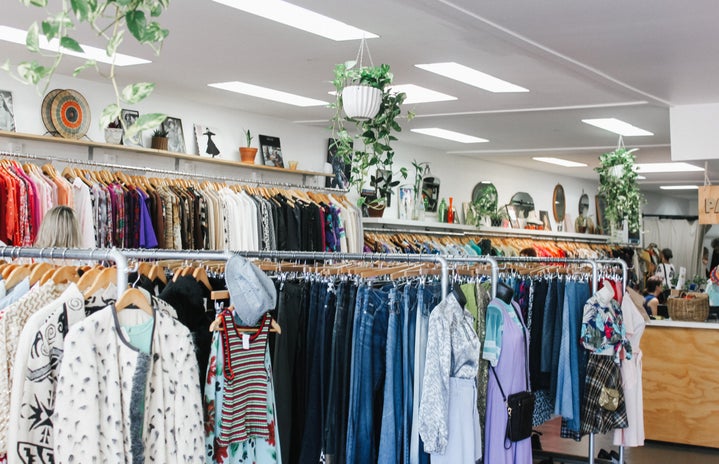As someone who has been trying to steer clear of fast fashion since about May, I worried that lockdown was going to make sticking to that much harder, since one of my main sources for sustainable fashion was charity shops. However, as frustrating as the closure of charity shops is, both parties, I think we can all appreciate that it was a necessary evil to try and get this pandemic under control. So, if you’re like me, desperately trying to stay away from fast fashion but struggling at the thought of not being able to browse in your favourite charity shop, I have a few tips for you.
The first place I am going to suggest for you to get your sustainable fashion fix is Depop. You probably already know about Depop, but it is such a great app that I just had to mention it. The great thing about Depop is that, like charity shops, you can buy great second-hand clothes, but you can also get rid of old clothes you no longer like. While Depop can be a great way to make a little bit of money, I’d suggest if you aren’t particularly in need of the extra cash, to donate it to charity. That way, even with the charity shops closed, you can still support the charities you would normally be supporting when shopping in their stores.
While Depop might seem like the most obvious place to get hold of sustainable fashion, rest assured it is not the only place. Contrary to what some may believe, buying clothing sustainably does not mean that you can only buy second-hand clothes. There are some brilliant sustainable brands out there that we should be making a point of buying from to help them grow. While I love second-hand clothes, sometimes it is nice to treat yourself to something new. A personal favourite of mine in terms of sustainable brands is Hundred Club. They are a brand who only ever make 100 pieces of each item of clothing they sell, as well as using sustainable materials and avoiding all plastic packaging. Having bought items from them before I can attest that the quality is lovely and they package the items with individual little thank you notes, which I think is a really nice touch. They’ve recently released new pieces, so I’d definitely recommend checking it out, as it does tend to sell out rather quickly.
The only catch to sustainable brands is that sometimes it can be hard to figure out which ones are genuine, and which are just claiming to be sustainable. Luckily, I have a tip for this too. There is an app called ‘Good On You’ which rates a brand’s sustainability. They class them into 5 categories: ‘we avoid’, ‘not good enough’, ‘it’s a start’, ‘good’ and ‘great’. What I particularly enjoy about this app is that it explains the reasons for a brand’s ratings. Often brands are classed as ‘we avoid’ or ‘not good enough’ because they just don’t provide enough information to be able to class them. They have three main issues that they base their judgement on – the brand’s treatment of their workers, their impact on the planet and their use of animal products. Another great feature it has is that when you type in a brand to see its score, if it comes up with a bad score, it then suggests alternative sustainable brands that are similar to the one you searched in the first place. So, if you’re struggling to find sustainable brands I’d seriously recommend downloading this app, although they don’t have every brand listed, I’ve found it really helpful in the past. It’s also a great way to just learn a little more about the reasons why fast fashion is so detrimental.
However, when we take initiatives like this, we have to appreciate that not everyone is in a privileged enough position to be able to do the same, no matter how much they may want to. A lot of sustainable brands can be quite expensive, and even Depop isn’t always the cheapest. So, if you’re not necessarily in a position to be buying loads of clothes, fear not there are a few alternative options. Upcycling clothes and just sewing in general is something I got really into during the first lockdown. With all the time spent indoors I know we’ve all found ourselves extremely bored at times, so this particular bit of advice may even solve two of your lockdown problems. There are so many different options with upcycling clothes. I personally started out just changing the lengths of sleeves on certain tops or making an old pair of trousers into shorts. One of the great things about it is that you don’t need to be an expert, there are so many tutorials on YouTube, and if you mess up it doesn’t matter because chances are you were upcycling something you didn’t wear anyway. The options are endless really, whether you just want to dye something a different colour, or completely change the style of it, it’s up to you. If you happen to get really into it you can even invest in a sewing machine and start making clothes from scratch. A great thing about essentially making your own clothes is that you can make whatever you want, you don’t have to be limited to what you can find in a shop.
Buying fashion sustainably is definitely a challenge, but it is possible, and even if you just want to cut down a bit, it’s such a great thing to do. Take it at your own pace, every little thing makes a difference. So, if you’re already committed to eliminating fast fashion from your life, hopefully this will help you survive the closure of charity shops, and if you’re not I hope this may inspire you to give it a go.



